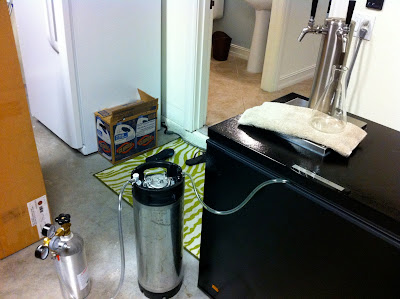Last Friday I received an order from Freshops! I am a longtime customer and have always been happy with their selection and quality. Along with 8 oz. each of Amarillo and Centennial, I opted to try a new hop called Citra. It's supposed to be jam packed with tropical flavor and aroma and is currently all the rage. Needless to say when I opened the bag, I was not disappointed. These hops are DANK. I left the pound ziplock baggie open inside while I was hopping the IPA I brewed today, and when I returned inside, the living room smelled like hops. AMAZING.
On to the brew day! I was so excited to get these new Citra hops that I decided to give them a whirl in a single hop IPA. This way I will get an idea of the flavor and aroma and other aspects of this hop without interference from other varieties. Here's my recipe. My online free brew calculator has me shooting for an OG of 1.063.
Nico's Sun Harvest IPA 11/07/2011
5.5 gallon batch
10 lbs. Rahr pale malt
2 lbs. Flaked Rye from Whole Foods
.5 lbs. Crystal 40L
Irish Moss at last 15 minutes of boil
.5 oz. Citra @ 75 minutes
1 oz. Citra @ 10 minutes
2 oz. Citra @ 5 minutes
2 oz. Citra @ flameout
Nottingham Dry Yeast rehydrated and pitched into wort at ~60F.
Damn these hops smell good!
I decided to leave the detailed instruction and photographs out of this post and future brew day posts. If you would like to see more instruction, check out Nico's Hoppy Wheat Treat from October 2011.
I cracked the grain and put the water on for the mash. I wanted a lower mash temperature this time because I like a dry IPA. I opted for 148F.
The mash sat for an hour as I did some other things around the house. Andi and I have stripped and painted a china closet (we removed the top). So I took this time to put on the final coat. I think it looks good.
Tobey was tired and wasn't much help brewing today. Between you and me, I think he did too many beer reviews last night.
Once the mash and sparge were complete, I decided to take a pre-boil gravity reading. It came in at 1.050. I think I'm right on so far. With a 60 or 75 minute boil, I should be right around the 1.060 mark. Andi wasn't much help either today...
NICO TIP
When you place a copper immersion chiller into boiling wort, make sure that the outlet tube ends are pointed away from you. You may have inadvertently left a small amount of water inside the chiller and steam burns suck. Use your head.
Anyways, I boiled the wort for about 75 minutes and added a ton of hops during the last 10 minutes of the boil. Then, I whirlpooled the wort and let sit for about 20 minutes before I drained it.
Check out how clear my false bottom gets my wort. Damn sexy.
Once the carboy was full, I carried it up to the fermentation room. I placed it in an ice water bath to cool it down since it was around 85F.
Damn, that's a lot of spent hops. I pulled some to the side so you can see the depth!
In the carboy pic above, I pulled off a bit of the wort so that I can test the gravity post-boil. Below, I am taking a temperature reading and then checking the gravity. I knew the wort was warm at the time, so it is necessary to adjust the specific gravity value depending on the wort's temperature. It was 80F. The OG turned out to be almost exactly 1.060 (adjusted for 80F, it's 1.062). Dead-on! BOO-YAH!!!
Nico's Dry Yeast Pitching Treatise
After a few hours in the ice water bath, it's time to rehydrate and pitch the yeast. My equipment is below.
Nico's Dry Yeast Pitching Method is the best. Nico says so. If you don't like it, don't do it. You'll just be making inferior product.
Get one bottle of spring water, swab the top with rubbing alcohol, dump out (and drink) 1/2 to 3/4 of the bottle, alcohol swab the dry yeast packet and scissors, cut the packet and dump into the water bottle. Put the cap back on, tighten, and shake. Let it sit for about 15-20 minutes, shaking intermittently. Pitch into your wort.
It's just that simple and that bad-ass. Check out some action shots below.
I'm really looking forward to this IPA. Updates to follow!






















